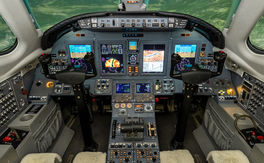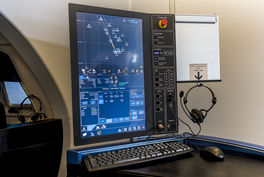One flight simulator - two cockpits: Our simulator has two cockpit configurations. In addition to the Citation XLS avionics, the XLS+ cockpit can be installed in a short time. Customers can choose between the Honeywell avionics and the Rockwell Collins suite. XLS and XLS+ training in one FFS!
We are your expert partner for initial and recurrent training for the Citation XLS and XLS+. Our teaching staff consists of pilots who have many years of experience on this type. Extensive courseware as well as modern tools such as desktop trainers for avionics and FMS training enable you to prepare optimally for the sessions.
Our modern training centre is located in Neusiedl am See, 20 minutes by car from Vienna Airport and 30 minutes from Bratislava Airport.
Pilot Training Courses
The ground course is taken in a small group. Usually, smaller classes yield better results. Flying the XLS/XLS+ often means the transition to a multi-pilot aeroplane. We refrain from inflexible CBT and focus on personal instruction, ensuring that each pilot acquires the knowledge, skills and competence levels required to successfully complete the theoretical exam. The flight training part is done in our Citation XLS/XLS+ Level D Full Flight Simulator. During the sim-sessions all normal, abnormal, and emergency procedures are systematically explained and practiced until each pilot feels safe and confident. Our dedicated instructors have vast experience flying the XLS and provide you with realistic scenarios. The landing training (base training) can be accomplished in our ATO right after the skill test.
C560XLS/XLS+ Type Rating course overview:
- 50 hours ground course
- 6 hours Fixed Base Sessions on FFS & 32 hours FFS training (16h PF and 16h PM)
- 2 hours skill test (2h PF)
- 20 days duration
Entry requirements for C560XLS/XLS+ Type Rating course:
The applicant must be a student pilot currently undergoing training on an MPL training course or meet the following requirements:
a. Have at least 70 hours of flight experience as PIC on aeroplanes;
b. Hold a multi-engine IR(A);
c. Have passed the ATPL(A) theoretical knowledge examinations in accordance with Part FCL;
d. Except when the type rating course is combined with an MCC course:
(i) Hold a certificate of satisfactory completion of an MCC course in aeroplanes; or
(ii) Hold a certificate of satisfactory completion of MCC in helicopters and have more than 100 hours of flight experience as a pilot on multi-pilot helicopters; or
(iii) Have at least 500 hours as a pilot on multi-pilot helicopters; or
(iv) Have at least 500 hours as a pilot in multi-pilot operations on single-pilot multi-engine aeroplanes in commercial air transport.
e. If applicant has not held any type rating of a SPA or MPA (Single Pilot High Performance Complex Aeroplane or Multi-Pilot Aeroplane) - the completion of an Advanced UPRT Course is madatory.
f. Good command of English (ICAO Level 4 or higher) A candidate having held a TR for a multi-pilot high performance complex aeroplane may be credited for 1.2 (c) if the multi-engine IR(A) lapsed less than 3 months prior and the candidate has a total flight time experience of min 500 hours on a multi-pilot high performance complex aeroplane and if written approval for attending the TR course has been issued by the competent authority issuing the candidates license.
This course is designed for pilots who already have more than 250 hours experience and a valid rating on a Cessna Citation aircraft of the 500-Series (i.e.: C525, C550/551/560,...). The course comprises all topics of the full type rating but has a shorter timeframe as it assumes a good understanding of Cessna Citation-related systems.
Type Rating for C560XLS/XLS+ Cessna Cross Qualifications course overview:
- 48 hours ground course
- 24 hours FFS training (12h PF, 12h PM)
- 2 hours skill test PF
- 15-17 days duration
Entry requirements for Type Rating C560XLS/XLS+ CCQ:
a. Have at least 70 hours of flight experience as PIC on aeroplanes;
b. Hold a multi-engine IR(A);
c. Have passed the ATPL(A) theoretical knowledge examinations in accordance with Part FCL;
d. Except when the type rating course is combined with an MCC course:
(i) Hold a certificate of satisfactory completion of an MCC course in aeroplanes; or
(ii) Hold a certificate of satisfactory completion of MCC in helicopters and have more than 100 hours of flight experience as a pilot on multi-pilot helicopters; or
(iii) Have at least 500 hours as a pilot on multi-pilot helicopters; or
(iv) Have at least 500 hours as a pilot in multi-pilot operations on single-pilot multi-engine aeroplanes in commercial air transport.
e. Good command of English (ICAO Level 4 or higher)
f. One or more valid type ratings with at least 250 hours experience on Cessna Citation aeroplanes of the 500-Series
g. In case of first type rating (of a Multi Pilot Aeroplane , like the C560XLS/XLS+ or for a Single Pilot High Performance Complex Aeroplane) - the completion of an Advanced UPRT Course prior type rating start is madatory.
The validity of the type rating is one year. The revalidation of your rating (LPC – license proficiency check) can be performed within 90 days prior to the expiry date issued in the license. If needed, we can offer a seat support (acting as pilot monitoring). Our examiners are registered with many civil aviation authorities and are able to perform proficiency checks or skill tests for all EASA member states.
If your type rating has expired, we offer renewal trainings to regain the level of proficiency required to safely operate the Citation C560XL/XLS/XLS+. The amount of refresher training needed is determined on a case-by-case basis and depends on the on-type experience of the applicant, the amount of time elapsed since the expiry of the validity period of the rating and the pilot’s overall flight experience. Our training department reviews your documents and prepares a training program customized to your proficiency. Please contact our sales department for more detailed information on the rules and procedures required by the different national authorities.
This course is designed for pilots who wish to instruct others on the aircraft or on the simulator. During the course you will gain the competence to manage the training process and to prepare type rating lessons.
The TRI/SFI course comprises 3 modules:
Module 1: Teaching and Learning
Introduction to training and instructing techniques, candidate evaluation and lecturing. This module will be credited if the applicant already holds or has held a flight instructor license.
Module 2: Technical Course & FFS Training
The Technical Course enables the instructor to teach the type-specific syllabus for the XLS/XLS+. Particular attention to multi-crew cooperation is taught in respect of panel flow patterns, checklist strategy, workload management and task sharing.
Module 3: Assessment of Competence
An Assessment of Competence concludes the TRI/SFI course. Depending on the extent of the desired privileges, the assessment takes place at the FFS (TRI restricted) and/or at the aircraft (TRI unrestricted).
TRI restricted
- privilege of type rating instruction on a FFS
(privileges granted depending on license-issuing authority: Conducting landing training on an aircraft after the type rating, privilege of conducting training flights for recent experience - 3 take offs, approaches and landings during 90 days- on a FFS or an aeroplane)
TRI unrestricted
- privileges of a TRI restricted
- privilege of type rating instruction on an aeroplane
Entry requirements for TRI for C560XLS/XLS+:
a) Hold a CPL, MPL or ATPL pilot license on the applicable aircraft category
b) Have completed 1500 hours flight time as a pilot on multi-pilot aeroplanes
c) Have completed, within the 12 months preceding the date of application, 30 route sectors, including take-offs and landings, as PIC or co-pilot on the applicable aeroplane type, of which 15 sectors may be completed in an FFS representing that type
Entry requirements for SFI for C560XLS/XLS+:
a) Hold or have held a CPL, MPL or ATPL pilot license on the applicable aircraft category
b) have completed the FSTD content of the applicable type rating course
c) have completed the proficiency check for the issue of the specific aircraft type rating in an FFS representing the applicable type, within the 12 months preceding the application
d) have completed 1500 hours flight time as a pilot on multi-pilot aeroplanes
e) completed, as a pilot or as an observer, within the 12 months preceding the application, at least:
(i) 3 route sectors on the flight deck of the applicable aircraft type (in a FFS or aeroplane); or
(ii) 2 line-orientated flight training-based simulator sessions conducted by qualified flight crew on the flight deck of the applicable type. These simulator sessions shall include 2 flights of at least 2 hours each between 2 different aerodromes, and the associated pre-flight planning and de-briefing
The Multi Crew Cooperation Instructor Course is designed for pilots who want to instruct in an MCC course. Additionally, the MCCI course expands TRI privileges from instruction in the single-pilot environment to the multi-pilot environment.
MCCI Course overview:
- 25 hours Teaching and Learning (this module will be credited if the applicant already holds or has held a flight instructor license.)
- 10 hours Technical Training
- 4 hours FFS training & Assessment of Competence
Entry requirements MCCI course:
The applicant must meet all requirements as set out in FCL.915.MCCI
- Hold or have held a CPL(A), MPL or ATPL(A);
- Have at least 1500 hours flight time
Aviation Academy Austria offers Differences Trainings from the XLS to the XLS+ and vice versa. Depending on the differences between the variants, the training comprises theoretical instruction, device training, FFS or aeroplane training. The amount of training for transiting from one variant to any other variant is determined in the EASA OSD report. The report defines training / checking / currency, operational credits, and other elements bearing the status of rule and AMC.
- Rockwell Collins 3000 FMS Training
- Universal FMS UNS1 Training
- Pro Line 21 Training
Operator Training Courses
In Business Aviation time is of the essence. Therefore, we help operators save time by performing company trainings and checks for them. All training will be configured based on your OMs and performed with maximum efficiency.
Per EASA PART-ORO.FC130, each flight crew member must complete a recurrent training relevant to the type of aircraft on which he operates. AAA customizes efficient and practice-oriented training which fulfils the requirements defined in the customer’s operations manual. The training is normally divided into a three-year cycle of ground school and flight instruction, covering all abnormal and emergency procedures. If needed, we can provide you with type-rated pilots who take over the duties of PM. Other modules may be included into the training.
Depending on the training specified by the airport authority and the operators’ manuals, the course familiarizes pilots with all aspects of operations at the respective airport, such as regulatory requirements, airport constraints, approach and departure operations, and human factors / CRM techniques that aid in safe flight operations. During an extended briefing, topics relevant to the operation are discussed, like AFM limitations, performance planning and criteria, the importance of thorough pre-planning for each arrival and departure, CRM issues regarding these operations, aircraft-specific procedures, and aircraft-specific performance calculations. In the subsequent practical FFS training all aspects of approach and departure operations as well as ground operations are trained. The FFS is equipped with up to date navigational and terrain information which is modelled in exact detail, providing a realistic environment.
The Low Visibility Operations (LVO) training prepares pilots to practice ground operations, low visibility take-offs and approaches (normal/emergency ops) as approved by the respective authority.
Pilots who are nominated by an operator to act in the role of commander must perform a command course comprising theoretical knowledge instruction, simulator training and an OPC flown from the left-hand seat. In some EASA member states, the proficiency check can be combined with an ATPL(A) skill test. The duration and content of the course depend on the complexity and size of the operation, as well as the defined training syllabus in the customer’s operations manual.
Commanders whose duties require them to operate in either pilot seat and carry out the duties of a co-pilot, or commanders required to conduct training or checking duties, must complete additional training and checking as specified in the operations manual. The additional training and checking must include at least the following: an engine failure during take-off; a one-engine-inoperative approach and go-around; and a one-engine-inoperative landing.
Dry Lease
Our Cessna Citation XLS/XLS+ Level D FFS is available for dry lease. Our sales team will assist you by allocating slots and customizing rental packages. Dry lease means rent only – the operation of the simulator is performed by the customer. This increases your flexibility and gives you the freedom to do any training or check flight in complete privacy, directed by your instructor or examiner of choice. We are happy to assist with transfer, car rental, accommodation, and leisure activities!


